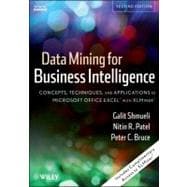Data Mining for Business Intelligence, Second Edition uses real data and actual cases to illustrate the applicability of data mining (DM) intelligence in the development of successful business models. Featuring complimentary access to XLMiner®, the Microsoft Office Excel® add-in, this book allows readers to follow along and implement algorithms at their own speed, with a minimal learning curve. In addition, students and practitioners of DM techniques are presented with hands-on, business-oriented applications. An abundant amount of exercises and examples, now doubled in number in the second edition, are provided to motivate learning and understanding.
This book helps readers understand the beneficial relationship that can be established between DM and smart business practices, and is an excellent learning tool for creating valuable strategies and making wiser business decisions. New topics include detailed coverage of visualization enhanced by Spotfire subroutines and time series forecasting, among a host of other subject matter.
The Second Edition now features:
-Three new chapters on time series forecasting, introducing popular business forecasting methods including moving average, exponential smoothing methods; regression-based models; and topics such as explanatory vs. predictive modeling, two-level models, and ensembles
-A revised chapter on data visualization that now features interactive visualization principles and added assignments that demonstrate interactive visualization in practice
-Separate chapters that each treat k-nearest neighbors and Naïve Bayes methods
-Summaries at the start of each chapter that supply an outline of key topics








